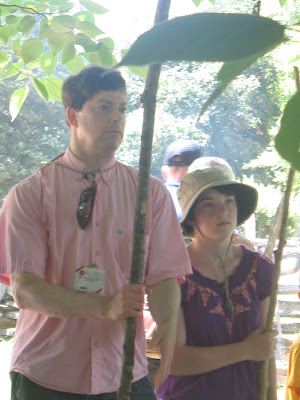There is so much to see at Colonial Williamsburg that we had to go back on Tuesday morning.
This is General Washington's horse.
Here's my buddy Captain Innis again. James Innis was born in 1754, in Virginia, son of the Rev. Robert Innes, a Scotchman. He was a graduate of William and Mary College. At the beginning of the troubles with the mother country, he rallied a band of students and secured some stores about to be secreted by Dunmore, and he was dismissed from college, the faculty being yet loyal to the crown. In February, 1776, as captain of the Williamsburg volunteers, he marched against the enemy at Hampton. In November following, as lieutenant colonel, he became an aide to Washington, and served at Trenton, Princeton, Brandywine, Germantown and Monmouth. In October, 1778, he was appointed a navy commissioner. In 1780 he entered the house of delegates. At the solicitation of Washington, he raised a regiment for home defense, and commanded it at the siege of Yorktown. He was a member of the convention of 1788, and eloquently supported the constitution. He then engaged in law practice and attained high rank at the bar, and later succeeded Edmund Randolph as attorney general. Governor Tazewell pronounced him "the most classical, the most elegant and the most eloquent orator" to whom he ever listened. Washington held him in highest esteem, and tendered him the attorney generalship, which his state of health obliged him to decline. He died August 2, 1798, before completing his forty fourth year, in Philadelphia, while discharging his duties as commissioner under Jay's treaty, and was buried in that city, in Christ Church burial ground, not far from the grave of Franklin.
Uh oh, girls. What'd you do?
The walk to and from the visitor's center featured some interesting plaques that take you back/forward in time. Here's the last one as you return to the modern age.
Captain Innis with a sword.
The governor orders the colonists to disperse.
In the military camp, we learned about colonial weapons and soldier rations. Claire and Rufus drilled.
We also visited more craftsmen, including this cabinetmaker.
And we learned how bricks are made. Colonial Williamsburg makes a lot of bricks, and did you know that the different colors are a result of the heat they obtain in the furnace?
Oyster shells are used to line many of the pathways.
They are also crushed and used in the bricks.
Tobacco drying.
Tuesday afternoon we left Williamsburg and stopped at the Cold Harbor battlefield.
The Battle of Cold Harbor was fought from May 31 to June 12, 1864 (with the most significant fighting occurring on June 3.) It was one of the final battles of Union Lt. Gen. Ulysses S. Grant's Overland Campaign during the American Civil War, and is remembered as one of American history's bloodiest, most lopsided battles. Thousands of Union soldiers were killed or wounded in a hopeless frontal assault against the fortified positions of Confederate Gen. Robert E. Lee's army.
On May 31, as Grant's army once again swung around the right flank of Lee's army, Union cavalry seized the crossroads of Old Cold Harbor, about 10 miles northeast of the Confederate capital of Richmond, Virginia, holding it against Confederate attacks until the Union infantry arrived. Both Grant and Lee, whose armies had suffered enormous casualties in the Overland Campaign, received reinforcements. On the evening of June 1, the Union VI Corps and XVIII Corps arrived and assaulted the Confederate works to the west of the crossroads with some success.
On June 2, the remainder of both armies arrived and the Confederates built an elaborate series of fortifications 7 miles long. At dawn on June 3, three Union corps attacked the Confederate works on the southern end of the line and were easily repulsed with heavy casualties. Attempts to assault on the northern end of the line and to resume the assaults on the southern were unsuccessful.
Grant said of the battle in his memoirs, "I have always regretted that the last assault at Cold Harbor was ever made. ... No advantage whatever was gained to compensate for the heavy loss we sustained." The armies confronted each other on these lines until the night of June 12, when Grant again advanced by his left flank, marching to the James River.
Cold Harbor was one of a series of battles in which the Federals tried to outflank the well-entrenched Confederates, with the two armies clashing repeatedly. See how the lines "bounce" on the picture below?
Remains of the trenches.
In the car, Hailey worked on my hat. She cut the crown down and sewed it back on to the brim so that it would fit better over my hair.
Rufus Lawless.










































No comments:
Post a Comment